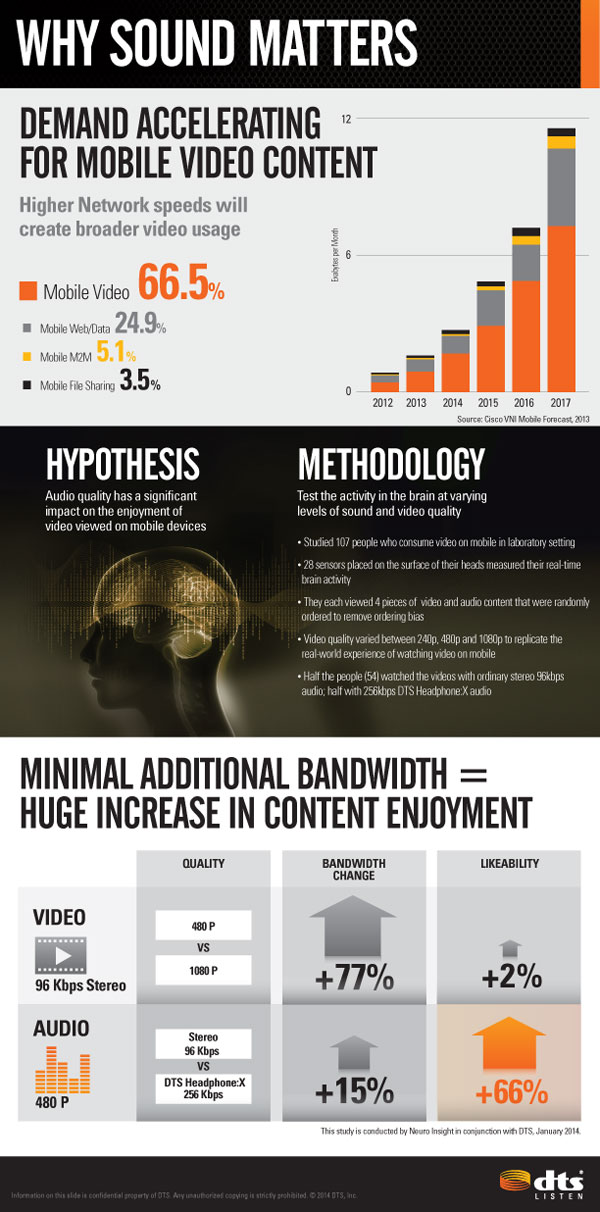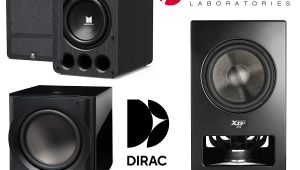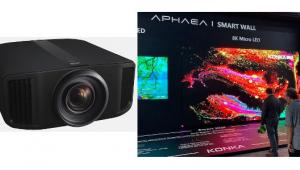For me, I was most impressed to hear that headphone:x is only 256kbps and that it can be used with ear buds--I thought special rigs were required.
DTS Studies Brainwaves to Prove Sound Really Matters Page 2

Infographic courtesy DTS
Interestingly, the study also showed that improving the video quality while keeping the sound constant with either 96 kbps stereo or 256 kbps Headphone:X had essentially no effect on either Global Memory or the Hedonic Index; the minor differences were statistically invalid. In other words, with the sound quality kept equal, jumping from 240p to 480p resolution or from either of those to 1080p video had a negligible effect—only about 2%—on the participant’s enjoyment of the experience.
So, what does all this actually mean? Well, if you’re DTS, you read it to mean that the modest 15% increase in signal bandwidth said to be required to add Headphone:X encoding to streamed mobile video content will yield a net 66% increase in the listener’s whoopee factor, while the 77% bump in bandwidth required to take the video from 480p to 1080p would net you a big fat goose egg in user enjoyment. That result clearly suits their marketing needs right now, as mobile video usage is predicted to be hogging 66.5% of the total mobile pipeline by 2016, and DTS would like nothing more than its technology to be commonly used for the audio portion of all that video.
But does it suggest that audio is really the king in the audio/video equation? Perhaps only in this specific instance. It’s important to note here that Headphone:X is being targeted at the mobile video market, so a 10-inch tablet viewed from a foot or two away was a perfectly appropriate test display to prove the point. But what would happen if the same experiment was conducted with a larger screen — say a 65-inch 1080p flatpanel, or perhaps a 100-inch projection screen? Experienced enthusiasts know that the larger the screen, the more obvious the native signal resolution becomes. And what if the headphones and virtual processing were replaced with a stereo pair of real speakers in a room, put up against a full-blown 5.1- or 7.1-channel surround-sound system? Would the improved audio experience continue to show a spike in the Hedonic Index? How much would the “likeability” factor jump when going from a stereo pair to a soundbar to a full-blown surround system? And would successive improvements in the video resolution continue to be so meaningless? What might happen if we vary screen size and test larger screens against smaller ones? What affect would that have in drowning out the Hedonic increases brought on by improved audio quality?
I raised these questions in an email to Neuro-Insight’s Yadav after he and the DTS team presented their research to me at Sound & Vision’s New York office. “You are absolutely right that this effect may not hold true where the screen is bigger and no headphones are used,” he wrote back. “Neither DTS or Neuro-Insight are claiming this to be true for larger screens, not just because that “seems” wrong, but because we haven’t tested that yet.” Nonetheless, my suggestion that he work with us to replicate the study in a real home theater environment for an article in Sound & Vision raised his eyebrows, though the hard costs of conducting such research would require financial support. “Intellectually, finding that out seems interesting,” he wrote back, “if we can find a client who can potentially use what they get out of the research.”
So…any takers out there? Inquiring eyes—and ears—want to know, finally, which of our senses really dominates the home theater experience.
Click below for video discussing the DTS research. For more about Neuro-Insight’s technology, visit www.neuro-insight.com.
)
- Log in or register to post comments


Sound impact to me has always been a huge part of multimedia. So many times, we use to capture the scenario by catching the its sound, and that's proved here but through typically performed experiment. What else the result could come.

with a 4k TV you have to seat very close to see the difference. But this is no recommended for optimal sound image and clarity. what is more important? resolution or audio quality?





































































